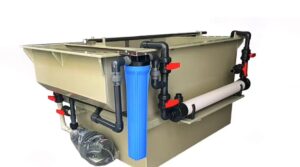The electrophoresis tank is divided into the main tank and the auxiliary tank. The design of the main tank requires that the distance between the workpiece and the tank bottom, electrode plates, and liquid level be generally greater than 20 centimeters, leaving space for the installation of the tank bottom, circulation nozzles on the tank wall, and the anode tube (or anode box). The transition between the tank bottom and the tank wall should be made in an arc shape to prevent the formation of dead corners in circulation. The design of the auxiliary tank bottom should be pyramid-shaped, and stainless steel coils are placed in the auxiliary tank for heat exchange, but external piping must be made of plastic.
Here is an introduction to the main components:
-
- Tank Construction: The tank body is made of pure PP (Polypropylene) material. PP is the optimal choice for tank material due to its good flexibility, resistance to acids and bases, smooth surface, standard thickness, and the ability to withstand temperatures up to 80°C.
-
- Internal Circulation System: The circulation system uses specialized jet nozzles for effective control of solution precipitation and ensuring sufficient circulation and uniform mixing of the tank liquid. Compared to traditional circulation systems that simply drill holes in the pipes inside the tank, this system greatly improves efficiency.
-
- Internal Filtration System: It uses PP/stainless steel bag-type filters. Depending on customer requirements, the filtration can also be designed separately for the electrophoresis tank. The new process’s filtration system is more efficient and secure compared to traditional methods.
-
- Anode System: It has a lightweight and well-designed structure, making it easy to install and dismantle on the tank wall and connect to the anode liquid circulation system during operation. The inherent active groups (R-CH2N+(CH3)3) in the membrane give it ion-selective permeability characteristics, effectively removing residual anions such as acid radicals from the tank liquid during the production process. This ensures that the two major characteristics of the tank liquid (pH value and electrical conductivity) are maintained within a specific range of process parameters throughout the entire continuous production cycle, thus ensuring the quality of the electrophoretic coating.
-
- Cooling System: The cooling and heating switch performs dual functions. It regulates temperature bidirectionally, saving costs and improving efficiency. It operates automatically without manual control, ensuring that the temperature of the coating solution inside the electrophoresis tank is maintained at 28°C (±2°C), ensuring the best possible product results.
-
- Conduction System: The electrophoresis machine’s main transformer has high magnetic permeability, low-loss magnetic cores, computer connectivity, digital display, or pointer display with fast response, allowing for easy adjustment. It is more energy-efficient, with a power savings of 15% to 30% compared to general thyristor rectifiers. It uses impedance magnetic cores to reduce ripple and peak current, making the output current close to direct current. It employs imported electronic components with good quality, low failure rates, long lifespans, and corresponding prices that are high but have low usage costs. It can be equipped with a communication interface to provide computer communication capability.

- Conduction System: The electrophoresis machine’s main transformer has high magnetic permeability, low-loss magnetic cores, computer connectivity, digital display, or pointer display with fast response, allowing for easy adjustment. It is more energy-efficient, with a power savings of 15% to 30% compared to general thyristor rectifiers. It uses impedance magnetic cores to reduce ripple and peak current, making the output current close to direct current. It employs imported electronic components with good quality, low failure rates, long lifespans, and corresponding prices that are high but have low usage costs. It can be equipped with a communication interface to provide computer communication capability.
